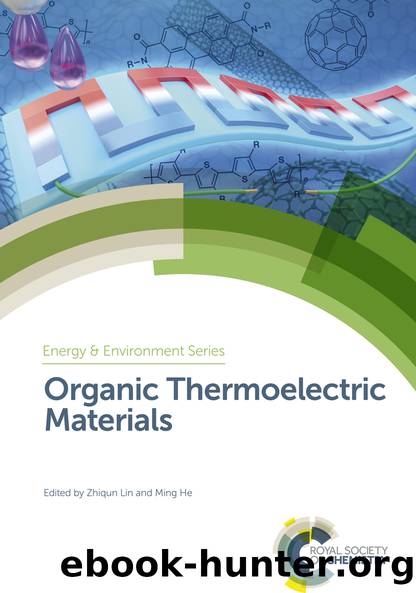Organic Thermoelectric Materials by Lin Zhiqun;He Ming;

Author:Lin, Zhiqun;He, Ming; [Неизв.]
Language: eng
Format: epub
ISBN: 9781788019163
Publisher: Book Network Int'l Limited trading as NBN International (NBNi)
Published: 2019-07-26T21:00:00+00:00
5.3.3 Improved TE Properties by CNT Composites
CNT have also been used as fillers to make composite TE materials. Different types of CNT are being used in varying amounts to get better TE properties. A few of these reports have been mentioned here and the effects of dispersed CNT on TE properties are mostly a trade-off between the electrical conductivity and the thermal conductivity. The ZT of an individual MWCNT is reported by Miao et al. 71 They have used the T-type method developed for evaluating the TE performance of 1D materials by Ma et al. 72 As shown in Figure 5.14, there are two heat sinks, A and D, and a nano-Pt sensor is suspended between them. Other than that, there are another four heat sinks B, C, E, F. MWCNT is attached on the one end to the Pt sensor and other end to the heat sink to make a T shape. Heat sinks A and D are used to apply the dc heating current, and heat sinks B and C are used to measure the dc voltage. Thermal conductivity is measured by heat current from nanofilm sensor, which also acts as heater, to the heat sink B and C via the MWCNT. The electrical conductivity of the MWCNT is measured by applying a dc current at heat sinks A and E and measuring the voltage developed at heat sinks C and F. Owing to the very high thermal conductivity of around 769.3 W mKâ1, the maximum ZT is reported 1.32 Ã 10â6 at 420 K.
Download
This site does not store any files on its server. We only index and link to content provided by other sites. Please contact the content providers to delete copyright contents if any and email us, we'll remove relevant links or contents immediately.
| Automotive | Engineering |
| Transportation |
Whiskies Galore by Ian Buxton(41529)
Introduction to Aircraft Design (Cambridge Aerospace Series) by John P. Fielding(32888)
Small Unmanned Fixed-wing Aircraft Design by Andrew J. Keane Andras Sobester James P. Scanlan & András Sóbester & James P. Scanlan(32573)
Craft Beer for the Homebrewer by Michael Agnew(17933)
Turbulence by E. J. Noyes(7700)
The Complete Stick Figure Physics Tutorials by Allen Sarah(7137)
Kaplan MCAT General Chemistry Review by Kaplan(6595)
The Thirst by Nesbo Jo(6435)
Bad Blood by John Carreyrou(6274)
Modelling of Convective Heat and Mass Transfer in Rotating Flows by Igor V. Shevchuk(6222)
Learning SQL by Alan Beaulieu(6035)
Weapons of Math Destruction by Cathy O'Neil(5828)
Man-made Catastrophes and Risk Information Concealment by Dmitry Chernov & Didier Sornette(5646)
Digital Minimalism by Cal Newport;(5389)
Life 3.0: Being Human in the Age of Artificial Intelligence by Tegmark Max(5184)
iGen by Jean M. Twenge(5161)
Secrets of Antigravity Propulsion: Tesla, UFOs, and Classified Aerospace Technology by Ph.D. Paul A. Laviolette(4990)
Design of Trajectory Optimization Approach for Space Maneuver Vehicle Skip Entry Problems by Runqi Chai & Al Savvaris & Antonios Tsourdos & Senchun Chai(4839)
Electronic Devices & Circuits by Jacob Millman & Christos C. Halkias(4747)
